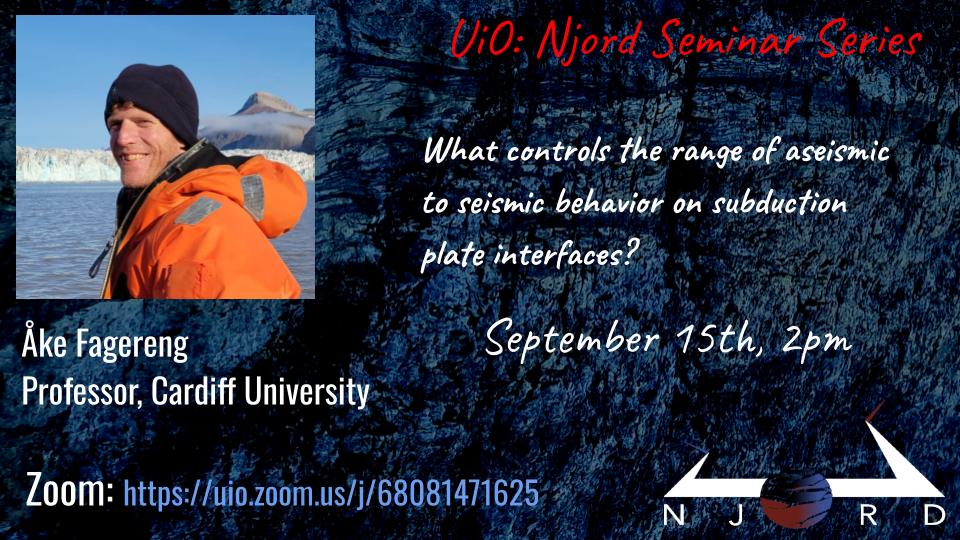Title of the talk: What controls the range of aseismic to seismic behavior on subduction plate interfaces?
There have been five instrumentally recorded earthquakes with magnitude ≥ 9.0, and all occurred on subduction interfaces. Yet, subduction megathrusts can also be steadily creeping, or produce ‘slow earthquakes’. We look at observations from subduction plate boundaries to discuss this range of fault slip styles, and address questions such as: What controls this continuum of behaviours? What is a ‘slow earthquake’? What are the characteristics of seismic and aseismic fault segments, and do these characteristics change with time?
Geological observations in exhumed accretionary prisms imply that the subduction thrust interface is a shear zone up to kilometres thick. In such zones, plate boundary displacement can be accommodated by volumetric, viscous deformation operating at shear stresses much lower than expected for frictional sliding. However, the existence of structures formed by brittle and frictional deformation, and geophysical observations of earthquakes and tremors, require that, locally and transiently, either (1) frictional strength is reduced, or (2) shear stress is increased.
One mechanism to reduce frictional strength is to increase fluid pressure. This will occur through ongoing metamorphic reactions in subducting sediments and oceanic crust, and provides one process that potentially leads to local frictional sliding. It is also possible that flattening and compaction within a wet viscous shear zone also generates local overpressure by pore volume reduction. These mechanisms implies that frictional failure is fluid- rather than stress-driven. A stress-driven form of failure may, on the other hand, arise from local strength heterogeneity, and where displacement is not fully accommodated by viscous shear. Whether failure is fluid- or stress-driven, whether a large damaging earthquake can be generated, or slip is limited to a slow event, becomes a function of the available area that can fail frictionally. This is consistent with the hypothesis that relatively heterogeneous fault segments, e.g. related to subduction of topographically rough seafloor, are less likely to produce large magnitude earthquakes than relatively homogeneous fault segments.
Short bio: Originally Norwegian, Åke Fagereng went overseas to finish school in Hong Kong, do a BSc at University of Cape Town (2005), and a PhD in geology at Otago University, New Zealand (2010). He went on to a position as Lecturer and then Senior Lecturer at the University of Cape Town, South Africa, before moving to Cardiff University in 2014, where he is now a Full Professor in Structural Geology. His research focuses on structure and rheology of faults and shear zones, and correlations between geological and geophysical observations of fault slip style. He has worked on exhumed subduction systems in New Zealand, Japan, Namibia, and the European Caledonides, and ocean drilling of the active New Zealand margin. He also studies exhumed strike-slip faults in Namibia and Cyprus, and active rifting in Malawi and Uganda. He thinks that metamorphic petrology is important and worries about the effect of fluids and melts on rheology. He has been funded by an ERC Starting Grant, the UK Global Challenges Research Fund, UK Research and Innovation (UKRI), South Africas National Research Foundation, and was recently awarded an ERC Consolidator grant to start in 2024. He was awarded the South African National Research Foundation’s President’s Award in 2013, and the Outstanding Young Scientist Award of the EGU Tectonics and Structural Geology Division in 2016. He is an Associate Editor for Geophysical Research Letters, edited a book, Geology of the Earthquake Source, for the Geological Society of London, and was recently appointed to the Editorial Board of Seismica. He is currently spending a year at the Centre for Advanced Study in Oslo as part of the project FricFrac led by Francois Renard and Anders Malthe-Sørenssen.
To get news, invitations to seminars and more from Njord, please go here to subscribe to our newsletter.
